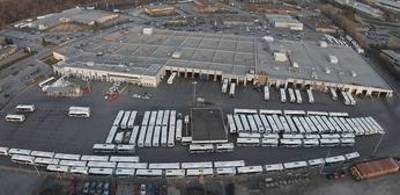Why build a second garage?
Over the past 15 years, the STO has seen a significant increase in its ridership, from 10.8 million passengers in 1994 to more than 20 million in 2015. That increased demand for public transit led to an increase in its fleet, from 186 vehicles to more than 305 currently, including the 61 articulated 60 foot-long buses, which require more space than the conventional 40 foot-long buses. The garage at 111 rue Jean-Proulx was built in 1977 and long ago reached full capacity, as a result of which more than 80 buses have had to park outdoors.
As well, the areas designated for the different work bays for vehicle repair and maintenance no longer meet requirements, resulting in numerous complications.

Everyday complications
- Impossible to wash and restock buses every day (gas, window-washer fluid, oil check, etc.);
- Shortage of space for regular maintenance;
- Parts warehouse used to full capacity;
- Difficulty finding space for the larger capacity newly acquired articulated buses;
- Difficulty finding space for the STO's new articulated buses;
- Rotation of buses (in-out-in) to access mechanical and specialized maintenance services;
- Insufficiently long work bays for the articulated buses.
Complications associated with very cold weather
- Outdoor parking of vehicles in very cold weather or ice storms carries its share of complications. In addition to buses that refuse to start, there is more risk of mechanical failure, frozen fuel lines and delays on the routes. These situations also mean a shorter life for the buses and reduce the chances of being able to get them back on the road;
- Less energy efficiency and higher heating costs due to repeated openings of the garage doors;
- Higher costs associated with clearing snow from bus roofs, required for safe handling on the road;
- More difficulty and time involved in clearing snow from the yard because of all the parked buses;
- Because the buses use up all the outdoor space, the STO has had to rent an adjacent lot to dump snow in the winter, which generated additional costs;
- In winter, when the buses are washed and parked outside, the layer of ice that forms can prevent doors from opening properly;
- When a bus is moved inside, the windows immediately fog up due to condensation. The windows then have to be ventilated, which takes time, before the bus can safely proceed.
Complications associated with very hot weather
- In the summer, in very hot weather, it takes longer to cool the passenger cabin, which requires burning more fuel.
Studies indicate a shortage of 4,000 square metres in the garage on rue Jean-Proulx. In order to adequately meet current and future requirements, the construction of a new facility was deemed to be the optimal solution.
Opening the new Centre will make it possible to limit activities at the Centre administratif Antoine-Grégoire garage to its optimal management and operational capacity, which is 160 buses, 15 of which are articulated.
In addition to all of the operational difficulties identified above, there are a number of other justifications for building the new Centre.
- To provide the amount of indoor space needed for the entire fleet based on current and future needs;
- To provide the necessary facilities and equipment for maintenance operations by setting up enough functional work bays large enough for articulated buses;
- To improve and properly manage effective STO activities and services;
- To provide facilities able to accommodate innovative technological solutions;
- To improve the movement of buses to the Rapibus throughout the territory, which will result in savings from moving vehicles to their route starting point.





